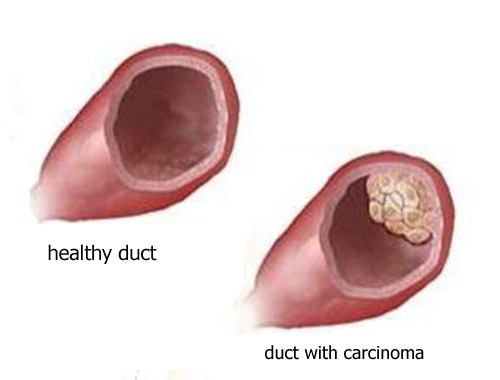Invasive Ductal carcinoma (IDC)

Published: 18 Jun 2025
ICD9: 233.0 ICD10: D05.10 ICD11: 2C61.0
Invasive Ductal Carcinoma (IDC) is the most common type of breast cancer.
Here's a breakdown of what it is:
Key Concepts:
![]() Invasive: This means the cancer cells have broken through the walls of the milk ducts and spread into the surrounding breast tissue. This is in contrast to "in situ" cancers, which are contained within the ducts. The "invasive" nature means it *can* potentially spread to other parts of the body through the lymphatic system or bloodstream.
Invasive: This means the cancer cells have broken through the walls of the milk ducts and spread into the surrounding breast tissue. This is in contrast to "in situ" cancers, which are contained within the ducts. The "invasive" nature means it *can* potentially spread to other parts of the body through the lymphatic system or bloodstream.
![]() Ductal: This indicates that the cancer started in the cells that line the milk ducts of the breast.
Ductal: This indicates that the cancer started in the cells that line the milk ducts of the breast.
![]() Carcinoma: This refers to a type of cancer that begins in cells that line organs and tissues (epithelial cells).
Carcinoma: This refers to a type of cancer that begins in cells that line organs and tissues (epithelial cells).
In simpler terms:
Think of the breast as having a series of tubes (milk ducts) that carry milk to the nipple. IDC is a cancer that starts in the cells lining these tubes. The cancer cells then escape the tube and invade the tissue around it.
Key characteristics of IDC:
![]() Most Common Type: IDC accounts for about 70-80% of all breast cancers.
Most Common Type: IDC accounts for about 70-80% of all breast cancers.
![]() Lump or Mass: It often presents as a lump or thickening in the breast. However, sometimes it's not palpable (felt) and is only detected through imaging like mammograms.
Lump or Mass: It often presents as a lump or thickening in the breast. However, sometimes it's not palpable (felt) and is only detected through imaging like mammograms.
![]() Variable Symptoms: Other symptoms can include nipple discharge, changes in breast size or shape, skin changes (dimpling or puckering), or a lump in the underarm area.
Variable Symptoms: Other symptoms can include nipple discharge, changes in breast size or shape, skin changes (dimpling or puckering), or a lump in the underarm area.
![]() Grading: IDC is graded based on how abnormal the cancer cells look under a microscope. The grade is a factor that help predict how quickly the cancer may grow and spread. Grades range from 1 to 3 (well-differentiated to poorly differentiated).
Grading: IDC is graded based on how abnormal the cancer cells look under a microscope. The grade is a factor that help predict how quickly the cancer may grow and spread. Grades range from 1 to 3 (well-differentiated to poorly differentiated).
Diagnosis:
IDC is usually diagnosed through a combination of:
![]() Physical exam: A doctor examines the breast for lumps or other abnormalities.
Physical exam: A doctor examines the breast for lumps or other abnormalities.
![]() Imaging tests: Mammograms, ultrasounds, and MRIs can help detect suspicious areas.
Imaging tests: Mammograms, ultrasounds, and MRIs can help detect suspicious areas.
![]() Biopsy: A sample of tissue is removed and examined under a microscope to confirm the diagnosis and determine the type and grade of cancer.
Biopsy: A sample of tissue is removed and examined under a microscope to confirm the diagnosis and determine the type and grade of cancer.
Treatment:
Treatment for IDC typically involves a combination of approaches, including:
![]() Surgery: Lumpectomy (removal of the tumor and surrounding tissue) or mastectomy (removal of the entire breast).
Surgery: Lumpectomy (removal of the tumor and surrounding tissue) or mastectomy (removal of the entire breast).
![]() Radiation therapy: Uses high-energy rays to kill cancer cells that may remain after surgery.
Radiation therapy: Uses high-energy rays to kill cancer cells that may remain after surgery.
![]() Chemotherapy: Uses drugs to kill cancer cells throughout the body.
Chemotherapy: Uses drugs to kill cancer cells throughout the body.
![]() Hormone therapy: Used for hormone receptor-positive cancers to block the effects of hormones that fuel cancer growth.
Hormone therapy: Used for hormone receptor-positive cancers to block the effects of hormones that fuel cancer growth.
![]() Targeted therapy: Uses drugs that target specific molecules involved in cancer growth and spread.
Targeted therapy: Uses drugs that target specific molecules involved in cancer growth and spread.
Prognosis:
The prognosis (outlook) for IDC varies depending on several factors, including:
![]() Stage of the cancer: How far the cancer has spread.
Stage of the cancer: How far the cancer has spread.
![]() Grade of the cancer: How abnormal the cancer cells look.
Grade of the cancer: How abnormal the cancer cells look.
![]() Hormone receptor status: Whether the cancer cells have receptors for estrogen and progesterone.
Hormone receptor status: Whether the cancer cells have receptors for estrogen and progesterone.
![]() HER2 status: Whether the cancer cells have too much of the HER2 protein.
HER2 status: Whether the cancer cells have too much of the HER2 protein.
![]() Age and overall health of the patient.
Age and overall health of the patient.
Early detection and treatment of IDC greatly improve the chances of a successful outcome.